
Publisher:
Bonnie King
CONTACT:
Newsroom@Salem-news.com
Advertising:
Adsales@Salem-news.com

~Truth~
~Justice~
~Peace~
TJP
Nov-29-2010 03:10

 TweetFollow @OregonNews
TweetFollow @OregonNews
Special Report: Mexico 1910-2010
Kent Patterson for Salem-News.comCelebrating 100 years of Mexican history.
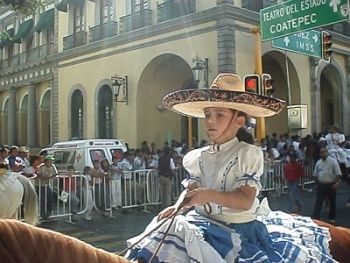 Mexican revolution day, 20th of November, 2004 (Xalapa) Courtesy: John Bokma |
(LAS CRUCES, N.M.) - While the US busied itself preparing for the annual Thanksgiving feast, Mexico took a step back into its own history. The 20th of November marked the 100th anniversary of the Mexican Revolution, the world's first great socio-political upheaval of the last century, as well as the beginning of a process that shaped the identity of modern Mexico.
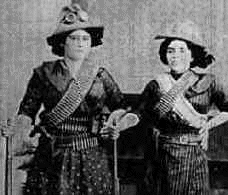 Women supporters of the Zapatistas |
The days preceding and following November 20 were filled with patriotic parades and displays of F-5 fighters over the capital, polemical fireworks in Mexico City, mountains of press commentaries, reruns of revolutionary-themed films, commemorative exhibits, debates over the roles of the Revolution's principal protagonists, and spots exalting the armed forces immersed in a so-called drug war that's claimed an estimated 28,000-30,000 lives since the end of 2006.
In the "Middle Mexico" city of Aguascalientes, a stunning exhibit of the works of pre-revolution and revolution-era photojournalists portrayed the mass deportation of indigenous Yaquis in 1905, a female Zapatista military commander, the 1914 US attack on Veracruz and women demanding work in Mexico City. Many of the photos evoked images from contemporary, violence-ridden Mexico, though with different socio-historic texts. Visitors to Aguascalientes' Regional Museum of History were first greeted with the picture of three men facing a firing squad.
"How gross," snapped a young girl who quickly scurried away, after viewing a photo of a revolutionary hanged from a tree in Michoacan.
In a nation embued with the capitalist ethic, the 1910 Revolution was commercialized. The El Cerrito pawnshop chain ran a Centennial raffle that promised participants would feel "more Mexican" after dispensing with pesos or prized possessions.
In return for pawning or buying items, especially the pricey PlayStations, cell phones and iPhones that one resident said clutter "The Peanut Life" of distracted consumers, the top winners were promised a 2010 Chevy or a new Honda motor bike.
Perhaps on a less crass but still costly note, Aguascalientes' La Saturnina restaurant offered "authentic recipes from the Independence and Revolution eras" for $10 a plate-the approximate equivalent of two minimum daily salaries.
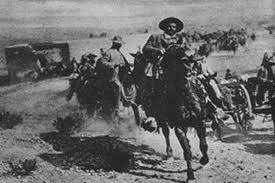 Francisco 'Pancho' Villa - U.S. Border Patrol |
Long marketed as a bottle of booze, the personage of Francisco "Pancho" Villa loomed large over the Centennial festivities. A cable rerun of Fernando de Fuentes' classic 1935 film "Vamonos con Pancho Villa" brought back to life the marauding calvalry charges, death-spewing trains and landmark battles that swirled around the life of the iconic, northern revolutionary.
Adapted from the Rafael F. Munoz novel and underwritten by the Mexican government, the film stands as one of the epic productions of the early 20th century. Arguably the Mexican equivalent of "Ben Hur," the fictional movie tells the story of the "Lions of San Pablo," six rural men who join up with Pancho Villa for no apparent reason.
One-by-one, the men are killed off, until one of the two remaining "Lions" is ordered by an emotionally detached Pancho Villa to kill the second surviving enlistee," lest the deathly-ill man infect the rest of the army. The distraught man complies with the order and dispatches his sickly friend, but then deserts Villa's cause. "Here, it is over," he mumbles. An estimated one million Mexicans died during the 1910-1917 Revolution. As depicited in "Vamonos con Pancho Villa," popular disillusionment with unfulfilled promises took hold, but the 1910 Revolution forged a new Constitution and a fresh State.
 1910 - 2010: "Native child--Mexico" by C.B. Waite - Flickr.com |
In the succeeding decades, Mexico sometimes led demands for Latin American independence from Washington, cultivated a growing middle class, enacted a broad but incomplete land reform, and nationalized its oil resources. But the heavy- handed, 70-year rule of the Institutional Revolutionary Party (PRI, coupled with widespread poverty and institutionalized corruption, stoked demands for democracy and justice.
By the early 1980s, the old State was on the chopping block, brought to its knees by oil-tempted debt. Bowing to International Monetary Fund and US Treasury Department dictates, and fluttering in the free trade winds lashing the globe, Mexican governments sold off the old paraestatal businesses, opened the door to greater foreign investment, privatized collectively owned lands and imposed an austerity regime on the working-class.
One-tenth of Mexico's population migrated north to the United States.
One hundred years after the 1910 Revolution, nearly nine out of ten banking assets are in the hands of foreigners, Canadians are scooping up mineral resources from Chiapas to Chihuahua and Chinese-made products are conquering everything from the textile market to the Mexican palate. In a land where a dairy industry once thrived, one- third of the milk is imported from abroad.
From November 2009 to November 2010, the purchase of Mexican government bonds by foreigners soared by more than 700 percent. Practically driving the last nail into the old state's coffin, legislation initially passed by the Mexican Senate last October would allow the outsourcing of virtually all public institutions from schools to hospitals for periods up to 40 years.
As the central State withered, powerful, private organizations-both legal and illegal-stepped in to fill the political and economic void. According to a recent report by the Mexican Senate, 71 percent of the country's muncipalities are under the effective control of organized criminal groups.
The process of Mexican "feudalization" spoken about by leading criminologist Edgardo Buscaglia has paralells not only in Russia and other countries afflicted by modern transnational crime, but also taps at deep strains in Mexican history when the unruly provinces challenged the rule of the Valley of Mexico, whether it was Aztec, Spanaird or Creole. Yesterday's Hacendados, Caudillos and Caciques find their contemporaries in the Tycoon, the Political Boss and the Capo.
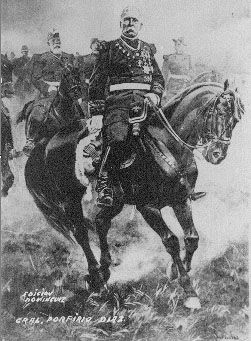 Pre-1910 Mexican dictator Porfirio Diaz |
A certain continuity from the 1910 Revolution and even before shapes the make-up of Mexico's political class. Across party lines, descendants of pre-1910 dictator Porfirio Diaz and his supporters as well as the different revolutionary factions are leading names in business and politics.
In the northern state of Chihuahua, for instance, descendants of pro-Diaz General Luis Terrazas, whose family controlled vast tracts of Chihuahua long before Vicente Carrillo and Chapo Guzman disputed the landscape, include National Action Party (PAN) Senator Santiago Creel Miranda Mexican Ambassador to Canada Francisco Barrio Terrazas (a former PAN governor of Chihuahua) and former PRI Governor Jose Reyes Baeza Terrazas.
A century after Mexico rose against the oligarchy overseen by Diaz, pressures for sweeping changes are again boiling to the surface. While the population of the country grew from 97.5 million people in 2000 to an estimated 112.3 million in 2010, the economy sputtered, growing by only 1.7 percent in the years from 2006 to 2010. At least half the population grapples with poverty, and as many as eight million young people-the so-called "Ninis"-do not have work or ready access to education.
As in 1910, burning questions simmer the political scene. What economic and political direction should Mexico take? How will change be achieved? In 2010, several currents of political thought compete to claim the future Mexico. Speaking on the Centennial day, President Calderon proclaimed that for Mexico to undergo "the profound transformation that we need," democracy must defended against those who would hurt it.
Finding common ground with Calderon, faith in Mexico's current electoral system is upheld by intellectuals Jorge Castaneda, Hector Aguilar Camin and Jose Woldenberg. The former president of the Federal Electoral Insitute, Woldenberg recently called anyone who did not support change through the ballot box "eccentric."
Critical of Mexico's much-touted democratic transition since 2000, others push a combination of electoral and mass action against unpopular political and economic policies. Left opposition leader Andres Manuel Lopez Obrador is the most prominent advocate of this approach, sometimes employing street protests like the 2008 mobilizations against proposed Pemex reforms while engaging in electoral politics.
"We are not for confronting injustice with violence," Lopez Obrador reiterated on November 20. A growing current of opinion seeks change by means of a massive, peaceful uprising of civil society. Countering Woldenberg, Proceso columnist John M. Ackerman took the occasion of November 20 to urge action outside the system.
"The fact is, this could be the only road that remains open to us to reconstruct our pained and sacked nation," Ackerman wrote. "Another revolution, this time peaceful and civil, is really necessary."
Though virtually ignored by the mainstream media, another quiet but not insignificant political tendency completely rejects the political system and instead favors the construction of "popular power" or autonomy at the grassroots level.
This political school is best represented by Chiapas' indigenous Zapatistas, who control a section of the southern state where they run their own schools, medical clinics and "good government" councils, in some ways reminiscent of the indigenous Mayan republic that lasted on the Yucatan Peninsula from the mid 19th century to the early 20th century. But today's Zapatistas are not alone.
Indigenous communities in Durango, Michoacan and Guerrero also have declared autonomy. Convened by the National Indigenous Congress and two Yaqui communities, a November 20 weekend meeting in Sonora reaffirmed the movement for self-governance.
Mexico's diverse indigenous groups were excluded in numerous ways from any benefits that flowed from the 1910 Revolution. So were women.
"The only thing that happened was to restore the Adelitas (1910 female revolutionary fighters)," said Sara Montes of Aguascalientes' Raiz Collective, in reference to media coverage of 1910 and its legacy.
More than a few Mexicans contend that change won't came to their country unless it is ushered in by the type of violence characteristic of the 1810 War of Independence or the 1910 Revolution. Cited by Mexico City's conservative Excelsior daily, a recent survey found that 14 percent of the respondents answered that poverty and inequality only could be resolved through armed struggle.
Life, meanwhile, trudges on for ordinary Mexicans, most of whom struggle to get by in a time of economic insecurity and political uncertainty.
As a near full-moon formed November 20 over Aguascalientes, the site of the historic 1914 revolutionary convention, thousands and thousands of people converged on the city center.
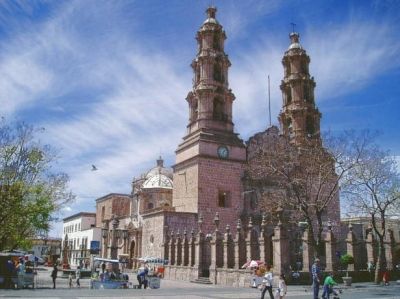 |
But the masses were not headed for revolutionary fireworks extravangas. Instead, they were going to quinceaneras, weddings, church festivities, weekend blowouts, and a performance of "The Mother of all Bands" El Recodo. Rivers of beer, increasingly of the Cuauhtemoc brewery that is agressively attempting to topple the Corona/Victoria/Pacifico empire of Modelo, flowed through bars, cantinas, homes and streets flanked by churches, pawnshops, roving beggars, hip cafes, and the Chinese restaurants that are suddenly popping up everywhere.
As revelers consumed huge quantities of beer and tequila in the bars lining the San Marcos Fair zone, a Catholic procession carrying the Virgin of Guadalupe standard approached the adjacent church.
Competing with Mariachi horns, "The Canon" greeted the pilgrims as it blared from the back of a large Coca Cola truck.
In a grand finale of sorts, the local PRI closed the Centennial with an athletic run, a juvenile martial arts demonstration and a wrestling match. Outgoing PRI Mayor Adrian Ventura staged folkoric dances and a 1910 exhibition by the state's public libraries. Displayed together with Madero, Villa and Zapata, was a large portrait of Fidel Velazquez, the Jimmy Hoffa-like character who ran Mexico's official labor movement for more than a half-century with an iron fist before finally succumbing to mortality in 1997. Velazquez, noted a biography attached to the old bulldog's mug, took power after beating out labor's left-wing headed by Vicente Lomardo.
Soon enough, the 1910 library displays were disassembled and the Centennial decorations removed from Aguascalientes' central plaza.
In rapid order, the revolutionary rememberances were substituted with Christmas greetings. In the center of the plaza that includes a map and explantion of Aguascalientes' importance on the old Camino Real between Mexico City and Santa Fe, a giant Christmas tree was erected and adorned with large metallic decorations showing Santa Claus slurping down Coca Cola.
On one side of the plaza, Elvis Costello and 1940s orchestra tunes livened up the day, while on another side barking marketeers for billionaire Carlos Slim's Telcel cell phone company lured customers with loud offers of cut-rate minutes to the United States.
Additional sources:
- Hidrocalido/Agencia Reform/Notimex, November 26, 2010. Articles by Veronica Sanchez and Enrique Valadez.
- La Jornada, November 21, 22 and 25, 2010. Articles by Juan Carlos Flores, Veronica Gonzalez, Patricia Munoz Rios, Hermann Bellinghausen, Victor Cardoso, Notimex, and AFP.
- La Cronica de Hoy, November 21, 2010. Articles by Luciano Franco and Daniel Blancas Madrigal.
- Proceso/Apro, October 24 and 21, 2010; November 21, 2010. Articles by Ricardo Ravelo, Rodrigo Vera, Arturo Rodriguez Garica, Jenaro Villamil,and John M. Ackerman.
Frontera NorteSur (FNS): on-line, U.S.-Mexico border news
Center for Latin American and Border Studies New
Mexico State University Las Cruces, New Mexico
Articles for November 28, 2010 | Articles for November 29, 2010 | Articles for November 30, 2010

googlec507860f6901db00.html
Salem-News.com:



Terms of Service | Privacy Policy
All comments and messages are approved by people and self promotional links or unacceptable comments are denied.
[Return to Top]
©2025 Salem-News.com. All opinions expressed in this article are those of the author and do not necessarily reflect those of Salem-News.com.